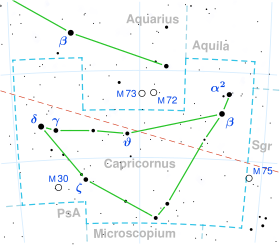Chi Capricorni
| Observation data Epoch J2000.0 Equinox J2000.0 (ICRS) | |
|---|---|
| Constellation | Capricornus |
| Right ascension | 21h 08m 33.62529s[1] |
| Declination | −21° 11′ 37.2177″[1] |
| Apparent magnitude (V) | +5.28[2] |
| Characteristics | |
| Spectral type | A0 V[3] |
| B−V color index | +0.01[2] |
| Astrometry | |
| Proper motion (μ) | RA: +19.83[1] mas/yr Dec.: −60.15[1] mas/yr |
| Parallax (π) | 18.14±0.31 mas[1] |
| Distance | 180 ± 3 ly (55.1 ± 0.9 pc) |
| Absolute magnitude (MV) | +1.59[4] |
| Details[5] | |
| Mass | 2.78 M☉ |
| Luminosity | 21[6] L☉ |
| Surface gravity (log g) | 4.33±0.14 cgs |
| Temperature | 10,878±370 K |
| Metallicity [Fe/H] | −0.41±0.06[7] dex |
| Rotational velocity (v sin i) | 212[3] km/s |
| Age | 251 Myr |
| Other designations | |
| Database references | |
| SIMBAD | data |
Chi Capricorni, Latinized from χ Capricorni, is a star in the southern constellation of Capricornus. Based upon an annual parallax shift of 18.14 mas as seen from the Earth,[1] the star is located about 180 light years from the Sun. It is visible to the naked eye with an apparent visual magnitude of +5.28.[2]
Properties
This is an A-type main sequence star with a stellar classification of A0 V.[3] It is a candidate Lambda Boötis star, showing a chemically peculiar spectrum with a low abundance of most elements heavier than oxygen.[7] The star is around 251[5] million years old and is spinning rapidly with a projected rotational velocity of 212[3] km/s. It has 2.78[5] times the mass of the Sun and is radiating 21[6] times the solar luminosity from its photosphere at an effective temperature of 10,878 K.[5]
At an angular separation of 1,199[9] arcseconds lies a faint proper motion companion designated HIP 99550. At the estimated distance of Chi Capricorni, this is equal to a projected separation of 28,300 AU.[9] It has a visual magnitude of 10.94[10] and a classification of M0 Vk,[11] indicating this is a red dwarf star.[9]
Chinese Name
In Chinese, 十二國 (Shíer Guó), meaning Twelve States, refers to an asterism which is represent twelve ancient states in the Spring and Autumn period and the Warring States period, consisting of χ Capricorni, φ Capricorni, ι Capricorni, 38 Capricorni, 35 Capricorni, 36 Capricorni, θ Capricorni, 30 Capricorni, 33 Capricorni, ζ Capricorni, 19 Capricorni, 26 Capricorni, 27 Capricorni, 20 Capricorni, η Capricorni and 21 Capricorni.[12] Consequently, the Chinese name for χ Capricorni itself represents the state Qi (齊),[13] together with 112 Herculis in Left Wall of Heavenly Market Enclosure (asterism).[14]
R.H.Allen had opinion that χ Capricorni, together with φ Capricorni, were represent the state Wei (魏).[15]
References
- ^ a b c d e f van Leeuwen, F. (2007), "Validation of the new Hipparcos reduction", Astronomy and Astrophysics, 474 (2): 653–664, arXiv:0708.1752, Bibcode:2007A&A...474..653V, doi:10.1051/0004-6361:20078357, S2CID 18759600.
- ^ a b c Evans, D. S. (1966), "Fundamental data for Southern stars (6th list).", Royal Observatory Bulletin, 110: 185, Bibcode:1966RGOB..110..185E.
- ^ a b c d Royer, F.; Zorec, J.; Gómez, A. E. (February 2007), "Rotational velocities of A-type stars. III. Velocity distributions", Astronomy and Astrophysics, 463 (2): 671–682, arXiv:astro-ph/0610785, Bibcode:2007A&A...463..671R, doi:10.1051/0004-6361:20065224, S2CID 18475298.
- ^ Anderson, E.; Francis, Ch. (2012), "XHIP: An extended hipparcos compilation", Astronomy Letters, 38 (5): 331, arXiv:1108.4971, Bibcode:2012AstL...38..331A, doi:10.1134/S1063773712050015, S2CID 119257644.
- ^ a b c d David, Trevor J.; Hillenbrand, Lynne A. (2015), "The Ages of Early-Type Stars: Strömgren Photometric Methods Calibrated, Validated, Tested, and Applied to Hosts and Prospective Hosts of Directly Imaged Exoplanets", The Astrophysical Journal, 804 (2): 146, arXiv:1501.03154, Bibcode:2015ApJ...804..146D, doi:10.1088/0004-637X/804/2/146, S2CID 33401607.
- ^ a b McDonald, I.; et al. (2012), "Fundamental Parameters and Infrared Excesses of Hipparcos Stars", Monthly Notices of the Royal Astronomical Society, 427 (1): 343–57, arXiv:1208.2037, Bibcode:2012MNRAS.427..343M, doi:10.1111/j.1365-2966.2012.21873.x, S2CID 118665352.
- ^ a b Andrievsky, S. M.; et al. (December 2002), "The elemental abundance pattern of twenty lambda Bootis candidate stars", Astronomy and Astrophysics, 396 (2): 641–648, Bibcode:2002A&A...396..641A, doi:10.1051/0004-6361:20021423.
- ^ "chi Cap". SIMBAD. Centre de données astronomiques de Strasbourg. Retrieved 2017-05-09.
{{cite web}}: CS1 maint: postscript (link) - ^ a b c Dhital, Saurav; et al. (June 2010), "Sloan Low-mass Wide Pairs of Kinematically Equivalent Stars (SLoWPoKES): A Catalog of Very Wide, Low-mass Pairs", The Astronomical Journal, 139 (6): 2566–2586, arXiv:1004.2755, Bibcode:2010AJ....139.2566D, doi:10.1088/0004-6256/139/6/2566, S2CID 661494.
- ^ Høg, E.; et al. (March 2000), "The Tycho-2 catalogue of the 2.5 million brightest stars", Astronomy and Astrophysics, 355: L27 – L30, Bibcode:2000A&A...355L..27H, doi:10.1888/0333750888/2862.
- ^ Gray, R. O.; et al. (July 2006), "Contributions to the Nearby Stars (NStars) Project: spectroscopy of stars earlier than M0 within 40 pc-The Southern Sample", The Astronomical Journal, 132 (1): 161–170, arXiv:astro-ph/0603770, Bibcode:2006AJ....132..161G, doi:10.1086/504637, S2CID 119476992.
- ^ (in Chinese) 中國星座神話, written by 陳久金. Published by 台灣書房出版有限公司, 2005, ISBN 978-986-7332-25-7.
- ^ (in Chinese)zh:北方中西星名對照表
- ^ (in Chinese)zh:北天中西星名對照表
- ^ Allen, Richard Hinckley (1963), "Capricornus", Star Names, Their Lore and Meaning, Dover, retrieved 2017-05-09.

